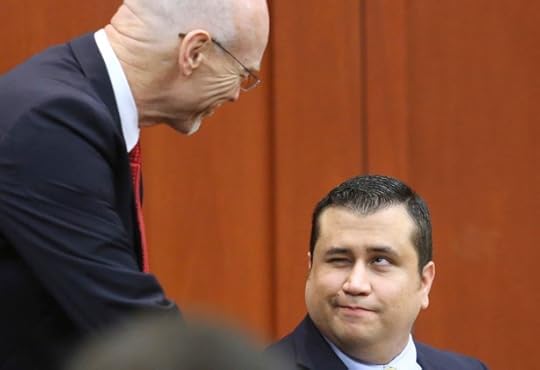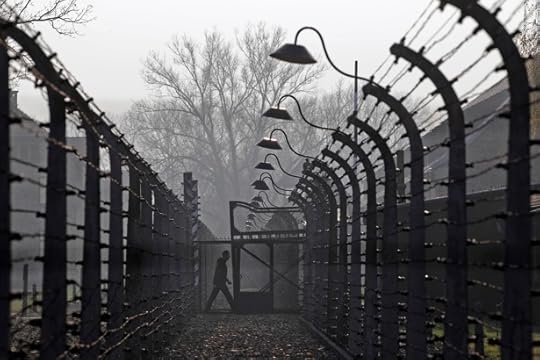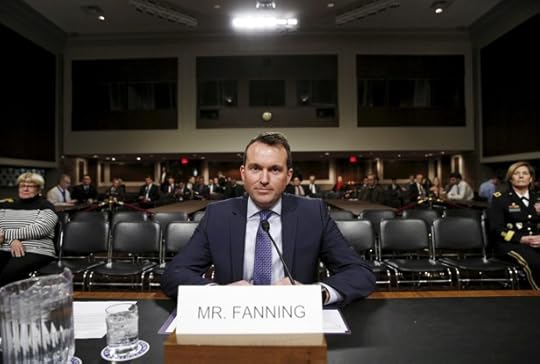Atlantic Monthly Contributors's Blog, page 163
May 18, 2016
The Gun That Killed Trayvon Martin Finds a Buyer

George Zimmerman said Wednesday he has sold the handgun he used to kill Trayvon Martin in 2012.
Though he did not specify how much the 9 mm Kel-Tec PF-9 pistol sold for, bidding for the weapon started at $100,000 when Zimmerman placed the gun up for sale on the United Gun Group website last week. The last offer was made by someone using the name “John Smith,” who bid $138,900 one minute before the auction closed, reports The Orlando Sentinel. The gun had recently been returned to Zimmerman by the U.S. Department of Justice.
In a statement on his website, Zimmerman said:
The process of notifying the winning bidder will begin immediately. The winning bidder will ultimately decide if they want their information to be maintained in confidentiality and they are assured that I will withhold their identity from all media and private parties.
Zimmerman was acquitted of murder charges for killing Martin, an unarmed 17-year-old, in Sanford, Florida. Zimmerman, who was a neighborhood-watch volunteer, said he shot Martin in self-defense. Proceeds of the sale will go to “several worthy causes,” he said, which includes combating the Black Lives Matter movement.

The Hidden Treasure in an Auschwitz Artifact

Auschwitz Museum staffers have discovered a woman’s gold ring and necklace in the false bottom of a mug, one of tens of thousands of enameled kitchenware looted by the Nazis during the Holocaust.
The jewelry was found while museum employees were conducting conservation work on the mug, which was on display. Over the years, the false bottom had eroded and separated from the mug. After X-ray and other testing, staff found the jewelry wrapped in a cloth.
Piotr Cywinski, the director of Auschwitz Museum, said in a statement Tuesday:
The hiding of valuable items—repeatedly mentioned in the accounts of survivors, and which was the reason for ripping and careful search of clothes and suitcases in the warehouse for looted items—proves on the one hand the awareness of the victims as to the robbery nature of the deportation, but on the other hand it shows that the Jewish families constantly had a ray of hope that these items will be required for their future existence.
The owner of the jewelry is not known. Curators say it was produced in Poland between 1921 and 1931. The museum honors the 1.1 million prisoners, mostly Jewish, who were killed in the Nazi death camp located in occupied Poland.

The International Space Station's First German Commander

European Space Agency astronaut Alexander Gerst will serve as commander of the International Space Station in 2018, making him the first German to hold the job, the agency said.
ESA Director General Jan Woerner said Wednesday that Gerst will lead the orbital station during a six-month mission starting in May 2018. German Chancellor Angela Merker joined the announcement at the European Astronaut Centre in Cologne.
Gerst is a geophysicist and volcanologist. He previously spent six months on the ISS as a flight engineer in 2014 for ESA’s Blue Dot mission, during which he conducted experiments focused on physical science, biology, and human physiology. He also took 12,500 pictures to make this six-minute timelapse:
Gerst will be the second European astronaut to serve as commander in the history of the station. Frank De Winne, of Belgium, held the job in 2009. Russian cosmonauts and American astronauts have taken turns commanding the station since humans began living there in 2000. Chris Hadfield became the first Canadian ISS commander in 2013.

The Ongoing Outcry Against the Ghostbusters Remake

Paul Feig first made his mark in Hollywood by creating the TV series Freaks & Geeks, a one-season wonder that became a cult hit long after its cancellation. He’s since become one of the biggest names in comedy film, directing blockbuster hits like Bridesmaids, The Heat, and Spy, often successfully blending high-octane action with broad humor. So he was a logical choice to reboot the Ghostbusters franchise with an all-female cast, not just because of his track record as a director, but also because he knew the headaches that awaited him. Speaking to the Daily News last year, he put it succinctly: “Geek culture is home to some of the biggest assholes I’ve ever met in my life.”
Feig’s Ghostbusters isn’t out until July 15, but since the project was announced in 2014 as a reboot of the hit 1984 film, starring Melissa McCarthy, Kristen Wiig, Leslie Jones, and Kate McKinnon, a vocal minority of movie fans have come up with specious reasons to criticize it. Hollywood does too many reboots; the sacred legacy of the original film is under threat; the jokes in the trailer aren’t funny enough. Things reached a fever pitch yesterday when James Rolfe, host of the popular “Cinemassacre” YouTube channel with over 2 million subscribers, announced that he wouldn’t even deign to watch the film. His reasoning dances around the simple fact that has set this innocuous-seeming movie apart from its fellow blockbusters this summer—that it’s a tentpole genre film starring women.
The Ghostbusters trailer is currently the most “disliked” movie preview on YouTube; some 800,000 fans have clicked the thumbs-down button, indicating an organized campaign against the film (for comparison, the Captain America: Civil War trailer has only 12,000 dislikes). Its comments thread is filled with fans defending their down-votes as being “on merit alone,” as if a major Hollywood studio film has never had shaky advertising before. Rolfe’s justification for skipping the movie focuses mostly on the arrogance of remaking a classic. “This isn’t just any franchise, this is Ghostbusters,” he intones, invoking the memory of the original film’s deceased star Harold Ramis.
Here are just some of the major franchises Hollywood has rebooted in the last decade: Batman. Superman. Spider-Man. James Bond. Star Wars. Planet of the Apes. Halloween. Friday the 13th. The Evil Dead. The Thing. Teenage Mutant Ninja Turtles. Robocop. Every Disney animated classic, starting with Cinderella and continuing with The Jungle Book this year. The list could go on endlessly, even without counting TV spinoffs. All have some provoked fan consternation, but final judgment is usually withheld until after the movie hits theaters. Ghostbusters, by contrast, has become a rallying cause for a swathe of fans who are beginning to resemble a movement not unlike the Gamergate nightmare that continues to plague the world of video games.
The vitriol directed at Ghostbusters seems to come in two forms: angry screeds in comments sections and people’s Twitter mentions, and videos like Rolfe’s, which try to justify the pushback as an idealistic defense of the original franchise’s legacy. Others look to dismiss the female cast as some sort of reverse-sexism, a “marketing gimmick” that diminishes the stars by turning them into tokens. “What offends me about this film isn’t that there’s women in it. Or even that the women are the protagonists. It’s that it’s going backwards 30 years in time and calling itself progressive,” one Cinemassacre commenter wrote. “I think the biggest reason this film will suck is they tried to shoehorn in a PC ideology instead of just telling a good story,” said another. Even the presumptive Republican presidential nominee Donald Trump joined the pile-on last year, the substance of his criticism amounting to “What’s going on!?”
Embedded in all of these preemptive and logically flimsy complaints is an obvious subtext: that the issue of appearance matters more than actual quality, and that the idea of a female cast taking up the mantle of a very male film series is just somehow wrong. The 1984 Ghostbusters is indeed a memorable touchstone of the era, an endlessly rewatchable sci-fi comedy that similar films should strive to imitate. Its 1989 sequel, however, is not worth defending, and efforts to make a third film sputtered out over creative differences and star Bill Murray’s outspoken disinterest in every script he was presented with. In short, it’s exactly the kind of franchise film studios look to revive: a well-remembered product that for one reason or another has fallen dormant.
Unlike many Hollywood reboots, Feig’s revival actually offers something different from what came before it. The prospect of a large-scale genre film starring only women (with men such as Thor’s Chris Hemsworth in supporting roles) was shocking enough that it prompted the announcement of an all-male Ghostbusters remake starring Channing Tatum last year. It seemed the film was intended as a kind of counter-balance to Feig’s film, but the idea was eventually scrapped because of its sheer irrelevance, as was any talk of a “Ghostbusters cinematic universe.” It’s impossible to know what Cinemassacre would’ve made of a Ghostbusters sequel starring Channing Tatum rather than Melissa McCarthy, but it’s likely there wouldn’t have been quite as much vitriol.
Rolfe’s video currently has more than 530,000 views on YouTube; it’s the latest and loudest addition to an outcry that’s been growing for more than a year, from the initial casting news to every new trailer and clip from the film premiering online. The film’s cast has largely ignored the toxicity online, but Feig has remained steadfast in trying to call out, debate, and refute criticism on his Twitter. When The Verge’s Emily Yoshida visited the film’s set last year, she asked him why he bothered to engage with such single-minded trolling. He said he simply didn’t want to give in.
“It’s the same thing that the women went through with Gamergate,” he said. “They were just getting hammered, and everyone says ‘Well, why don’t you just go offline?’ But it’s like getting chased out of your neighborhood ... I don’t want to get chased off the Internet.” For all the hate, Ghostbusters can’t be chased out of theaters; for all the YouTube dislikes, the film is tracking to be one of July’s biggest openers in a summer clogged with reboots and sequels. Fans will surely debate the film’s quality for years to come, but for a sad subset, that question has already been settled.

The First Openly Gay Army Secretary in U.S. History

In January of this year, Eric Fanning testified before the U.S. Senate Armed Services Committee on his nomination to be the next secretary of the Army. The line of questioning from lawmakers was standard for hearings with military officials these days. Is the United States winning the war against ISIS? How long until Iraqi troops regain control of Mosul? What’s the status of the military’s plan to integrate women into combat roles?
As with any job interview, Fanning’s life outside of work didn’t come up. But that omission is what made the Senate’s decision to confirm Fanning as the 22nd Army secretary this week such a historic moment: Fanning is now the first openly gay leader of a U.S. military service, and the highest-ranking openly gay Pentagon official in the country’s history.
The Senate confirmed Fanning by unanimous voice vote on Tuesday, eight months after President Obama to replace John McHugh, who held the position for six years. When McHugh left in November, Fanning was named acting secretary. But Senator John McCain, the Republican from Arizona and chair of the Senate Armed Services Committee, argued Fanning should not serve in the job while his confirmation was pending, and he resigned in January, just over a week before his confirmation hearing. The Senate Armed Services Committee voted to move Fanning’s nomination forward in March, but it was stalled until this week for reasons unrelated to the job. Senator Pat Roberts, the Republican from Kansas, had placed a hold on Fanning’s nomination as he sought assurances from Obama administration officials that they would not move any Guantanamo Bay detainees to Fort Leavenworth, in his home state. Roberts said Tuesday he had received them from Robert Work, the deputy defense secretary.
“Practically speaking, the clock has run out for the president” to transfer prisoners out of Guantanamo, said Roberts in a speech on the Senate floor. Roberts said Fanning “has always had my support for this position.”
“My issue has never been—let me make that very clear—with Mr. Fanning’s character, his courage, or his capability,” he said. “He will be a tremendous leader.”
LGBT groups and their supporters praised the confirmation Tuesday. “Eric Fanning’s historic confirmation today as Secretary of the U.S. Army is a demonstration of the continued progress towards fairness and equality in our nation’s armed forces,” said Chad Griffin, the president of the Human Rights Campaign, the largest gay-rights organization in the U.S. “History was made today,” said the 83-member Congressional LGBT Equality Caucus in a Facebook post. “We’ve come a long way from don’t ask, don’t tell.” Fanning, on his official Twitter account, @SECARMY, retweeted a congratulatory message from Ellen DeGeneres that read, “5 years & we’re already running the place.”
In 2011, Congress repealed the “don’t ask, don’t tell” policy that since 1994 banned openly gay men and women from serving in the U.S. military and forced LGBT service members to hide their sexual orientation.
Fanning has never served in the military, but the Army secretary is a civilian position. Fanning has held several senior positions at the Pentagon, including acting under secretary of the Army, under secretary of the Air Force, and deputy under secretary of the Navy. One of his first jobs in Washington was as a staffer on the House Armed Services Committee.

The Queen’s Speech

With the backdrop of all the pomp and circumstance one would expect from a royal address, including a parade of horses and the Diamond Jubilee stagecoach, Queen Elizabeth II announced the British government’s intentions to seek some of the biggest prison reforms in the country’s history.
The queen’s speech at the State Opening of Parliament is a tradition that dates back to 1536, where the ruling monarch announces the majority government’s agenda for the year ahead in parliament. Prime Minister David Cameron, the leader of the Conservative Party, is proposing 21 new bills that include a tax on sugary drinks and education initiatives. However, prison reforms, which the queen said would “increase life chances for the most disadvantaged,” stood out.
The BBC highlights the initiatives:
One of Europe's biggest jails, HMP Wandsworth, is among six institutions where governors will be given new powers over budgets and setting the daily regime.
Satellite tracking tags which monitor the movements of offenders using GPS technology will be piloted in eight police areas from September, in a move which could see prisoners become weekend inmates and spend the rest of the week at home as they hold down jobs.
Prisons will also be forced to publish statistics on education, reoffending and inmates' employment on release.
Opposition leader Jeremy Corbyn of the Labour Party said some of the proposed legislation makes the United Kingdom a “driverless car heading in the wrong direction.” Even so, the BBC reports the queen’s speech and the government’s agenda was still overshadowed by the looming June 23 referendum, where British voters will determine whether the country stays in the European Union.

A Christopher Columbus Letter Makes Another Voyage Across the Atlantic

A rare copy of a letter that Christopher Columbus wrote in 1492, detailing his voyage to the Americas from Spain, was returned to an Italian library after U.S. officials determined the document had been stolen.
The eight-page letter, one of 80 surviving copies published between 1493 and 1497, had been sitting in the Library of Congress in Washington since 2004 as a gift from an anonymous donor. The letter, written to King Ferdinand and Queen Isabella of Spain, described the New World’s people and scenery. But, as the Los Angeles Times details, officials recently discovered the letter’s true owners.
In 2012, agents with Immigration and Customs Enforcement got a tip that one of the rare copies — printed in Rome by Stephan Plannek in 1493 — had been stolen from the Riccardiana Library in Florence, Italy, and replaced with a forgery.
The tipster, who was not identified, had been conducting research when he came across the letter and “strongly suspected” it was a fake, agent Mark W. Olexa of ICE's Homeland Security Investigations wrote in court filings.
Olexa wrote that ICE agents, Italian law enforcement officials and experts examined the copy, which was bound in a volume of other works, and concluded it was indeed a fake.
A few months later, ICE agents got another tip that the original was actually located in the U.S. Library of Congress. An examination of the letter there revealed it was the original.
The Associated Press reported, citing American officials, that both the final owner and the Library of Congress acquired the letter in good faith. U.S. officials retrieved the letter from the Library of Congress and gave it back to their Italian counterparts, making yet another voyage across the Atlantic Ocean.

May 17, 2016
Mexico's President Calls For a Country #SinHomophobia

Mexican President Enrique Peña Nieto has announced that he will seek to legalize gay marriage in the country, giving support to a Supreme Court decision that last year recommended all states allow same-sex couples to marry.
Nieto met with representatives from LGBT rights groups Tuesday in honor of the International Day Against Homophobia and Transphobia. In a series of tweets after the meetings, Nieto said he opposed all forms of discrimination, and that he would propose an initiative to legalize same-sex marriage.
Por un @Mexico incluyente que reconoce en la diversidad, una de sus mayores fortalezas #SinHomofobia. pic.twitter.com/6ooZGuPEsD
— Enrique Peña Nieto (@EPN) May 17, 2016
“For an inclusive Mexico that recognizes diversity,” the tweet read, “one of their greatest strengths. #NoHomophobia.”
Nieto also said he would seek changes in passport policy that would allow the documents to list the preferred gender of transgender individuals.
Nieto said he would seek to allow same-sex marriage by changing Article 4 of the country’s constitution, according to the Mexican newspaper El Universal. “There cannot be in our country some states and entities that have certain rights and other that don’t,” he said.
Mexico’s Supreme Court ruled in June 2015 that laws barring same-sex couples from marrying were unconstitutional and urged states to pass similar laws in accordance. The decision did not overturn state laws, which has meant that gay couples who want to marry must sue in each state where it is outlawed. Only a few states, like Coahuila, Jalisco, Chihuahua, as well as in Mexico City, allow same-sex marriage.
Nieto said Tuesday Mexico will join a group of countries in the United Nations that have worked in different capacities to promote LGBT rights across the globe. A rainbow flag watermarked his Twitter avatar, and his wallpaper image read “#SinHomophobia.”

The Long Airport Lines of Summer

If passengers are flying out of Chicago’s O’Hare airport, they need to arrive three hours before their flight.
That’s what airport officials are telling passengers at one of the busiest airports in the United States. Security lines across the country have been historically long recently because of an increase in travelers, and the problem is expected to get worse in the upcoming summer months. While the Transportation Security Administration says it plans to hire an additional 800 officers this month, the union that represents security officers argues the agency needs to hire 6,000 more officers to address shortfalls nationwide.
The problem arises with the TSA doing more with less, reports the Chicago Tribune:
The TSA has received permission from Congress to shift $34 million to pay for additional officers. About $26 million will go toward additional hours for front-line officers, including more overtime and part-time officers, while another $8 million will be used to hire 768 officers this month instead of in September as planned.
The TSA now has about 42,000 officers, down from 47,000 in 2013. During the same period, passenger volume has risen 15 percent, to 740 million from 643 million, according to the American Federation of Government Employees, which represents TSA officers.
Lawmakers like Senator Dick Durbin, an Illinois Democrat, have said that if more people signed up for TSA PreCheck, it could ease the long lines. But according to TSA officials, only 7.25 million people have signed up, far short of the administration’s goal of 25 million by 2019.
However, until then, there will be more horrifically long lines nationwide, like this one last week 30 miles south of O’Hare at Chicago’s Midway airport.

The Night Manager: From the BBC With Love

In Britain, the question of who gets to play James Bond is a fraught one, replete with animus, deeply rooted bias, uncomfortable racial undertones, and an inordinate amount of hand wringing. So, naturally, it falls to the bookmaker to offer both levity and guidance when it comes to working these feelings out. Right now, PaddyPower.com is offering odds of 40/1 for the Scottish hunk Gerard Butler, 150/1 for the Harry Potter star Daniel Radcliffe, and 500/1 for the Leicester City striker Jamie Vardy (inflated, no doubt, by Leicester’s only slightly less plausible Premiership win earlier this month).
In February, a week before The Night Manager premiered on BBC One, Tom Hiddleston’s odds were 20/1. Since then, he’s become such an overwhelming favorite that British bookies have stopped taking bets on him. This is certainly helpful when it comes to getting free publicity (last year odds suddenly shortened on Damien Lewis, spurring feverish speculation about the prospect of a red-headed Bond). But it’s also testament to the wanton glamour and spectacular panache of the six-part miniseries—evidence of its sheer Bondiness, for want of a better word. From the undulating shapes and symbols in the opening credits to Hiddleston’s enigmatic, slightly perturbing performance as the show’s hero, the entire product feels like nothing so much as the world’s most elaborate audition tape for 007: fabulous locations, arch-nemeses, beautiful women, and all.
The Night Manager, whose fifth episode airs on AMC Tuesday night, is actually based on a book by that other great interpreter of British spycraft, John le Carré. Published in 1993, the tale of a soldier turned hotel employee who’s swept into the orbit of a roguish arms dealer was le Carré’s first novel not set during the Cold War, and in many ways it seems inspired by Ian Fleming’s star creation. Consider how the book’s hero is introduced in chapter three:
Jonathan Pine, orphaned only son of a cancer-ridden German beauty and a British sergeant of infantry killed in one of his country’s many postcolonial wars, graduate of a rainy archipelago of orphanages, foster homes, half-mothers, cadet units, and training camps, sometimes army wolf-child with a special unit in even rainer Northern Ireland, caterer, chef, itinerant hotelier, perpetual escapee from emotional entanglements, volunteer, collector of other people’s languages, self-exiled creature of the night and sailor without a destination, sat in his sanitary Swiss office behind reception, smoking his third unusual cigarette ...
In the series, Pine (Hiddleston) is first introduced as the night manager of a Cairo hotel struggling to make his way to work during the Arab Spring in 2011. He’s preternaturally calm amid the chaos, soothing customers, and pushing them smoothly to the ground when gunshots ring out outside. Later a woman, Sophie (Aure Atika), sashays through the lobby; another hotel employee tells Pine she’s the mistress of Freddie Hamid, whose family owns half the city, and is described as “everything the protesters hate. Incredibly wealthy. Corrupt to the core.”
Sophie asks Pine to make a photocopy of a document that’s come into her possession detailing arms purchases between Hamid and Richard Roper (Hugh Laurie), a British businessman seen in the opening minutes of the series delivering a bland TED-style talk about philanthropy. Contrary to his public face as a savior of refugees and orphans, Roper is a peddler of everything from napalm to nerve gas, and is described by Sophie as “the worst man in the world.” Pine sneaks a copy of the document to an English friend of his at the embassy, and before long Sophie is murdered in retribution (but not before the two sleep together in an Egyptian hideaway when he tries to help her escape).
Four years later, Pine is working in a hotel in Switzerland when he first encounters Roper face to face, newly arrived with his entourage: a fixer named Major Corkoran (Tom Hollander), two armed security guards, and his gamine American girlfriend, Jed (Elizabeth Debicki). Still haunted by Sophie’s murder (literally—the show’s hammiest scenes feature her ashen corpse entreating him to act), Pine retrieves sim cards from Roper’s trash and delivers them to the last contact he had at MI6, Angela Burr (the outstanding Olivia Colman). Soon, and rather improbably, Burr decides to plant him inside Roper’s operation, staging a kidnapping in Spain that makes Pine a trusted new member of his inner circle.
The plot, it’s worth noting, is a little janky. Would British intelligence really draft a rookie into such an elaborate sting operation? Would Roper, consistently informed by various MI6 sources that there’s a mole in his shop, not suspect the new guy whom he barely knows and oddly found working in a seafood restaurant several thousand miles away from his previous career? Probably not, and none of it really matters because the whole is executed so enticingly. The director Susanne Bier (best-known for her remarkable 2006 Danish drama After the Wedding) makes a case for why Hollywood should poach her immediately, taking the necessary components of spy movies—countless languorous shots of exotic locales, high-level corruption, monstrously charming villains, an ethically ambiguous hero—and forming them into something even better.
The Night Manager feels like nothing so much as the world’s most elaborate audition tape for 007.
Beyond the obvious, though, Bier finds something fascinating in the relationship between Pine and Roper. Laurie is habitually charming as the arms dealer, but his performance is undercut with persuasive menace that belies his interactions with the younger man. There’s something paternalistic about his adoption of this scrappy murderer who’s oddly good with kids (MI6 gave Pine a hefty criminal record to preempt Roper’s background check): He seems to radiate pride when Pine is fitted for his handmade suits, and when Pine masterfully smooths over a row when Corkoran makes a scene in a Monte Carlo restaurant. Hiddleston’s Pine, by contrast, is enigmatic throughout, and his allegiances (at least thus far) seem impossible to parse. Yes, his army background means he’s revolted by the human cost of Roper’s business, but he also seems drawn to the exuberant way in which Roper lives his life. Violence comes easily to Pine, and Hiddleston’s implacable energy adds to the sense of anxiety that suffuses the series.
Bier mimics his character’s appeal aesthetically: Roper’s life comes in shades of vivid blue and green, from his architecturally dazzling Mallorca base to the opulent hotels he frequents in Madrid and Monaco. Burr meanwhile is relegated to an office in London so chilly that her breath condenses in front of her face. Scenes within MI6 seem grey and washed-out by comparison (the supporting cast includes Outlander’s Tobias Menzies, Homeland’s David Harewood, and Men Behaving Badly’s Neil Morrissey). But Colman anchors the show’s morality in the fourth episode when she delivers an extraordinary speech revealing why she’s so intent on bringing Roper down, and reminds viewers that his breezy charm hides a capacity for singular cruelty.
With two episodes left, it remains to be seen whether Pine will succeed in reeling Roper in. But the show—rumored to be the BBC’s most-expensive series ever—is evidence of how television has increasingly shown itself to be superior to film when it comes to storytelling, from ambition and scope to sheer visual flair. On the heels of last year’s Spectre, which offered up a laughably weak plot and a pallid performance from Daniel Craig, The Night Manager not only manages to redeem the good old-fashioned spy story, but to make it sing.

Atlantic Monthly Contributors's Blog
- Atlantic Monthly Contributors's profile
- 1 follower



